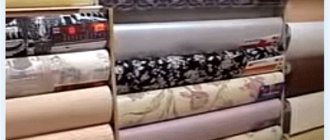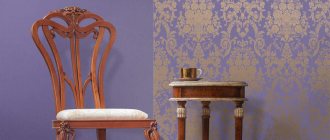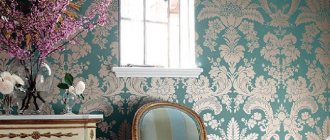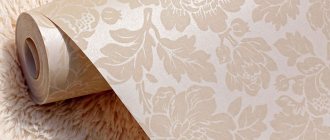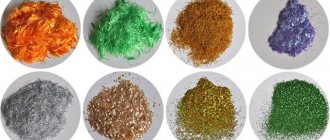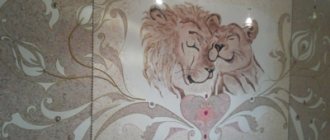What is acrylic wallpaper?
Acrylic wallpaper consists of two layers : the first is paper, the second is foamed acrylic. The latter is not applied in a continuous layer, as is the case with the vinyl analogue, but pointwise, which allows you to obtain a relief pattern and a breathable surface. The layer of foamed acrylic is about 2 mm. For comparison, vinyl wallpaper has an outer layer of 4 mm, which explains some of the differences in materials. A thinner coating layer means less weight, but also less wear resistance.
The name “acrylic” refers to a group of polymers based on synthetic resins that foam well and hold their shape.
History of acrylic
The name of this material most often refers to the colloquial name of a special polymer, which is used in the production of high-tech finishing and building materials. In addition, acrylic is used to create sanitary ware and kitchen countertops.
The material itself was invented in the distant thirties of the last century in Germany. At that time it was organic glass without any special additives. Of course, at that time this material had worse characteristics compared to modern samples. Over time, such organic glass began to be actively used to create various polymers, which are combined into a group called “acrylic”.
Advantages and disadvantages of acrylic wallpaper
Based on the structure of the material, one can judge its key properties. Among the advantages, it is worth highlighting the following qualities:
- high wear resistance;
- the material can withstand mechanical damage, so it can be used in apartments where children and animals live;
- Acrylic wallpaper can be washed , so the appearance will remain flawless for a long time. You can only wash with a slightly damp soft cloth and without using detergents, but this is also not bad;
low cost . If we compare acrylic wallpapers with their direct competitor, vinyl wallpapers, they are somewhat cheaper;- acrylic wallpapers breathe , which allows them to be used not only in hallways, like other washable wallpapers, but also in living rooms or even bedrooms;
- Mold or mildew will not develop in acrylic wallpaper;
- Thanks to the large selection of colors and textured surface, acrylic wallpaper can be used in almost any room and match many interior styles. Moreover, the relief allows you to hide some of the imperfections of the walls, but we are not talking about holes and cracks.
There are not many disadvantages of the coating - they can be found if you compare it with other types of wallpaper and find fault.
Due to the small thickness of the outer layer, the coating wears out faster, but this is relative, because the service life of the material is 10 years or more, depending on operating conditions and maintenance. Among the disadvantages, the inability to wash acrylic wallpaper with detergents is also often cited, but this does not prevent the use of water to remove contaminants.
The best manufacturers
- The modern wallpaper market is represented not only by domestic manufacturers, but also by European ones. The best include companies such as Rasch, Erismann Germany and the Loimina factory Russia.
- Rasch products have been represented on the Russian market for more than two decades. The Russians highly appreciated the quality and design of the wallpapers presented by this company, whose assortment also includes inexpensive vinyl, non-woven, acrylic and paintable collections.
- Another company from Germany, Erismann, is a success among Russians. It produces high-quality non-woven wallpaper, including those with acrylic coating. The models of this company are distinguished by their sophisticated design and durability.
- The Russian manufacturer Brand Loimina presents the best premium non-woven wallpaper on the domestic market.
When choosing trellises for your home, give preference to quality, reliability, and design.
How to choose acrylic wallpaper?
All manufacturers produce the material using a similar technology: the base is always paper, the coating is acrylic. This simplifies the choice, because you don’t have to understand the intricacies of different technologies. In addition, today acrylic wallpaper on a non-woven basis ; they are included in expensive collections of European manufacturers. This material is characterized by increased wear resistance and durability.
When purchasing material, it is better to pay attention to the parameters of the rolls. The length is usually 10.5 m, and the width ranges from 0.5 to 0.9 m . If the room is small, then it will be more convenient to work with narrower wallpaper, and there will be much less scraps. When it comes to spacious rooms, it is appropriate to use the widest possible material: this will allow you to quickly complete the installation and reduce the number of joints.
The price of acrylic wallpaper varies widely and depends on the name of the manufacturer, country of manufacture, relief, pattern, year of release of the collection and some other factors. In this regard, everyone should sensibly assess their own budget. Experts recommend not to chase the most expensive wallpaper from imported companies, but to trust the choice to a manufacturer with a proven name, and it doesn’t matter whether the wallpaper is domestic or foreign.
The main thing you need to decide when choosing acrylic wallpaper is what the design will be . Firstly, it is necessary to take into account the size of the room, its style, orientation relative to the cardinal directions, the color of furniture and textiles, and secondly, from all the variety that the construction market offers, choose the appropriate option. This is not an easy task, but a few useful tips will help you cope with this problem:
light shades visually expand the room and are a universal solution for most apartments in typical multi-storey buildings . Bright colors and large drawings also hide space, so owners of small rooms should avoid them too. In this case, it is better to use pastel and delicate shades with small patterns;- compensate for the lack of lighting with wallpaper in warm colors: peach, yellow, coral, apricot. If the room is southern and there is, on the contrary, too much sunlight in it, then it is better to opt for cool colors: light green, blue, light blue;
- You don’t have to stop at wallpaper alone, because two types of material can be combined with each other . Usually they choose plain wallpaper with a pattern in the same tone, but a combination of different colors, different patterns against the background of the same color, etc. is not excluded. You can alternate different wallpapers, use them for one of the walls, or divide the wall horizontally. There are a lot of combination options, and the result is an interesting interior;
- Wallpaper does not have to be chosen to match the furniture - this is already a thing of the past, but all interior items in the room should be in harmony in color and pattern.
When purchasing acrylic wallpaper, make sure that all rolls are from the same batch. This gives more guarantees that the material will not differ in shade. The packaging of products must be intact and durable; the presence of quality and safety certificates, as well as instructions for gluing, is strictly necessary.
Acrylic wallpaper is great for rooms such as the living room or bedroom, as the material “breathes”. Such wallpaper would be appropriate in a hallway that does not go directly onto the street, but acrylic wallpaper is not suitable for kitchens, where something is constantly and actively being prepared, and for baths.
Features of care
When caring for paper-based acrylic wallpaper, do not forget about its “tenderness”. This is why rough brushes and sponges can do a lot of damage to them. The most important rule is to be careful and not to overdo it.
For cleaning use ordinary water. If a stain appears on the wallpaper, you can additionally use detergent. His choice should be taken carefully. You can find a good quality product in supermarkets.
Cleaning the contaminated area is done by applying detergent to a rag and then rubbing it. After this, the problem area is wiped with a washcloth soaked in clean water.
Attention! Do not use abrasive products to clean acrylic wallpaper. They can damage the surface of products.
Using this or that finishing material, people wonder, is it safe? Acrylic wallpaper on a paper basis is a product that fully meets the requirements of GOST, which means there is no danger in using it. That is why they are great for the living room, office, and children's room.
Home renovation is the need to create a clean, cozy and attractive corner. Beautiful wallpaper will help not only decorate a room, but do it stylishly. Acrylic wallpaper is a great option that meets modern trends. Despite the wide variety of finishing materials, they have become quite popular and in demand due to their excellent properties and characteristics, because with the ability to “breathe” the air in the room will always be clean and free of harmful substances.
How to glue paper-based wallpaper can be found in the video below:
Acrylic wallpapers are becoming very popular among buyers. They are similar to vinyl, but the acrylic coating is much thinner and allows air to pass through it more easily. Acrylic is one of the most environmentally friendly materials.
Acrylic wallpaper is thin and environmentally friendly Recently, acrylic wallpaper has become increasingly popular
How to hang acrylic wallpaper?
Acrylic wallpaper is no more difficult to hang than paper or vinyl, but still some subtleties should be taken into account. Installation is carried out end-to-end , but some talk about the possibility of gluing them overlapping, if the pattern is such that the junction of the two canvases will not be very noticeable.
Although acrylic wallpaper can hide some wall defects, large cracks and unevenness must be smoothed out . Of course, if there are remnants of other finishing on the walls, then before starting work you need to get rid of it. For leveling you will need putty, and if the surface is far from ideal, then it is better to use plaster. Another option is to level the walls with plasterboard, but this method is only relevant for very damaged walls and provided that there is enough space in the room.
After leveling, be sure to prime the surface of the walls . You need to choose a composition that is suitable for the base material: concrete, brick, drywall, etc. As a last resort, you can dilute wallpaper glue and treat the walls with the resulting solution.
After all this, it’s a good idea to mark the walls to make installation easier. Since gluing is usually started from the corner near the window, a distance equal to the width of the wallpaper is set aside from it. A strictly vertical line is drawn along the mark, and the required distance is again set aside from it. You can do without this stage, but if a person who is not very experienced in this matter is working, then such markings will help achieve a more accurate result.
Now it's time to cut out the wallpaper itself . If they are plain, then there will be a minimum of problems. It is enough to know the height of the walls and add 4-5 cm to it for allowances. If there is a pattern on the canvases, then it must be combined correctly: the manufacturer indicates how many centimeters will be needed to combine the pattern. The consumption of such wallpaper will be significantly higher. For more accurate cutting, it is advisable to measure the height of the walls in several places to make sure that it is the same everywhere, otherwise you need to take into account errors when cutting wallpaper.
Glue for acrylic wallpaper is prepared according to the instructions for it. The process is simple and usually involves adding a specific amount of water to the powder and mixing thoroughly. When the glue is ready, it is applied to the wallpaper , which is carefully applied to the wall and pressed from top to bottom. Since acrylic wallpaper is elastic, it can be moved slightly during installation. Air is removed from under the material using a roller, which is used to smooth the surface from the center to the edges. It is better to carry out the installation together.
After the wallpaper is hung, it is left to dry for a day or two, and the room must be ensured that there are no drafts and the temperature is 18-220C.


